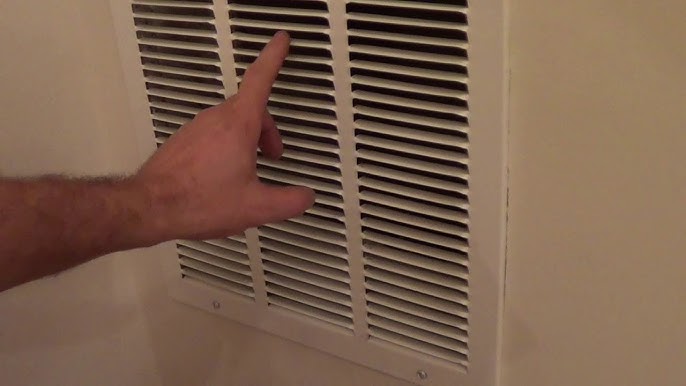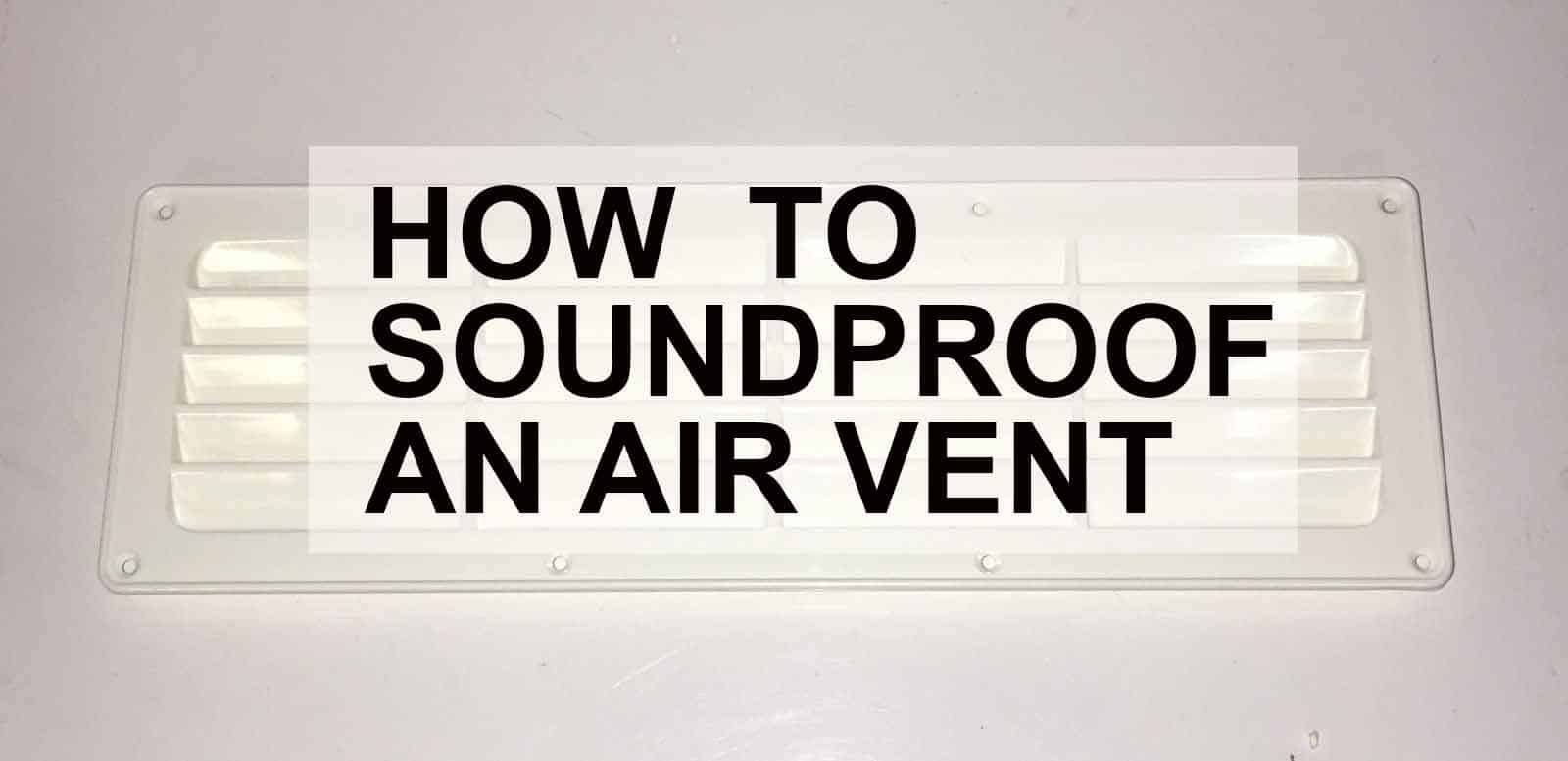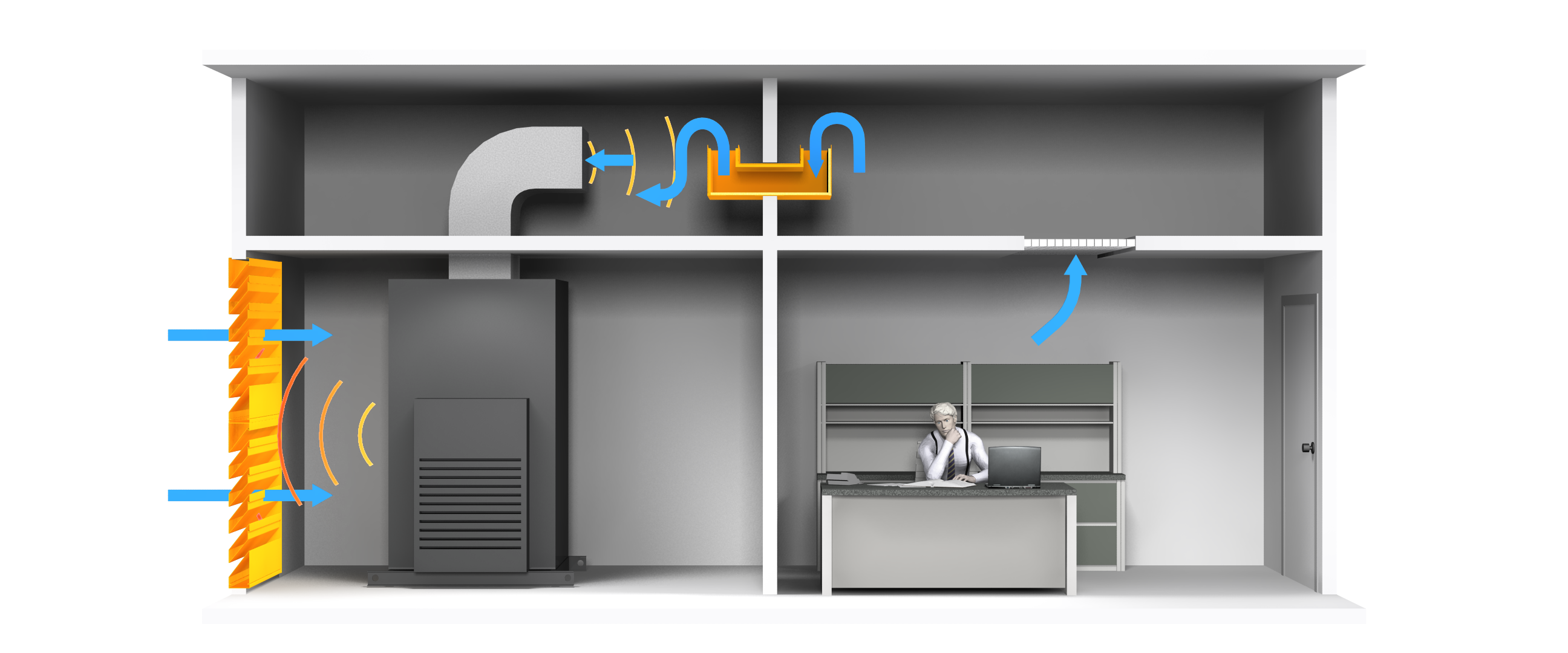Ever found yourself cranking up the TV volume to drown out the persistent hum from your return air vent? You’re not alone.
That relentless noise can be more than just a minor annoyance; it can disrupt your peace, affect your concentration, and even impact your sleep. But what if you could transform your home into a quieter, more serene space? Imagine enjoying a peaceful evening, free from the buzzing and whirring that has become all too familiar.
This article is your guide to achieving just that. You’ll discover simple, effective strategies to reduce noise from your return air, allowing you to reclaim the tranquility of your home. Keep reading to find out how small changes can make a big difference in your daily comfort.
Identify Sources Of Noise
Identifying sources of noise is crucial in reducing sound from a return air system. Check for loose ductwork, vibrating components, or airflow obstructions. Address these issues to minimize noise and improve indoor comfort.
Identifying the sources of noise in a return air system can be a game-changer in your quest for a quieter home. The return air system is essential for maintaining air circulation and temperature balance. However, it can sometimes become a source of unwanted noise, affecting your comfort. Identifying where the noise originates is the first step in solving the problem. With a bit of attention and the right approach, you can pinpoint these sources effectively.
Check For Loose Ducts
Loose ducts can create a rattling or banging noise as air moves through the system. It’s a common issue in older homes where the ductwork may have loosened over time. Secure any loose sections with duct tape or screws to minimize the noise.
Examine Air Grilles And Vents
Air grilles and vents can also be culprits of noise. Sometimes, they vibrate due to the force of the air passing through. Tightening the screws or adding padding can help reduce or eliminate the vibrations.
Inspect The Fan And Motor
The fan and motor inside the return air system can become noisy if they’re not functioning properly. Regular maintenance can keep them running smoothly. Look for signs of wear or debris that might be causing the noise.
Evaluate The Duct Size And Design
Duct size and design can significantly affect noise levels. Undersized ducts can create a high-pitched whistling sound, while poorly designed ones might cause turbulence. Consider consulting a professional to assess if your duct system is optimally designed.
Consider External Factors
Sometimes, the noise isn’t from the system itself but from external factors like nearby machinery or even wind. Assess the surroundings to rule out external noise sources. It might be an unexpected but simple fix. Once you’ve identified the noise sources, the next steps become clearer. Have you ever discovered a surprising source of noise in your home? Share your experience and help others on their journey to a quieter living space.

Credit: www.youtube.com
Use Soundproofing Materials
Dealing with noise from a return air can be quite frustrating. Whether it’s the constant hum or occasional rattles, it can disrupt your peace. Thankfully, using soundproofing materials can dramatically reduce this noise. These materials are designed to absorb sound and prevent it from traveling through walls and vents. Let’s dive into some effective options like acoustic panels and weatherstripping.
Acoustic Panels
Acoustic panels are a great choice for reducing noise. They are designed to absorb sound waves and minimize echo. You can easily add them to the walls around your return air vent. This creates a quieter environment by trapping sound before it escapes.
My friend once transformed his home office by installing acoustic panels. The difference was night and day. Suddenly, his video calls were free from distracting background noise.
Consider the color and style of panels to match your decor. It’s not just about function; they can enhance the look of your space too. Have you ever thought about how a simple design change can improve your comfort?
Weatherstripping
Weatherstripping isn’t just for doors and windows. It’s an effective soundproofing tool for return air vents too. By sealing gaps, it prevents sound from leaking through. This simple addition can make a big impact.
Think of it like putting on earmuffs in a noisy environment. It blocks out unwanted noise and creates a more peaceful setting. Imagine sitting in your living room without hearing the mechanical hum from the vent.
Easy to install, weatherstripping can be a quick DIY project. Why not give it a try? You’ll find that a quieter home is just a few steps away.
Install A Sound Baffle
Reducing noise from a return air system can transform your living space. Installing a sound baffle is an effective way to achieve this quiet haven. Sound baffles act as barriers that absorb sound waves, preventing them from bouncing around and creating noise. This solution is both practical and affordable, making it a popular choice for homeowners.
Understanding Sound Baffles
Sound baffles are designed to minimize sound transmission. They work by disrupting the path of sound waves. This disruption reduces the noise that reaches your ears. Baffles are often made from materials like foam or fiberglass. These materials are known for their excellent sound absorption properties.
Benefits Of Installing Sound Baffles
Installing sound baffles can significantly decrease unwanted noise. They help improve the overall acoustics of your home. This creates a more peaceful environment. A quieter space can enhance relaxation and focus. Sound baffles are also easy to install and maintain.
Types Of Sound Baffles
There are different types of sound baffles available. Foam baffles are lightweight and simple to use. Fiberglass baffles offer superior sound absorption. Both types can be customized to fit your space. Choosing the right type depends on your specific needs.
Installation Tips
Proper installation is key to maximizing the effectiveness of sound baffles. Ensure the baffles are correctly positioned in your return air system. Position them to intercept sound waves directly. Check for any gaps that might allow sound to escape. Regular maintenance will keep them performing well.
Cost Considerations
Sound baffles are a cost-effective solution. Foam baffles tend to be cheaper. Fiberglass options may cost more but offer better performance. Evaluate your budget and desired level of noise reduction. Investing in sound baffles can save money in the long run by reducing energy costs.
Improving Home Comfort
Sound baffles not only reduce noise. They also contribute to energy efficiency. By absorbing sound, they can help maintain a stable temperature. This can lead to lower heating and cooling costs. Enjoy a quieter and more comfortable home environment.

Credit: soundproofingguide.com
Adjust Fan Speed
Lowering fan speed can significantly reduce noise from return air systems. This adjustment helps to minimize airflow turbulence, resulting in quieter operation. A quieter home environment is achieved by optimizing fan speed settings.
Adjusting the fan speed of your return air system can significantly reduce noise levels in your home. It’s a simple yet effective method that can make a big difference. Imagine being able to enjoy a conversation without the constant hum of the fan in the background. Many homeowners overlook this option, but it’s worth considering if you’re dealing with persistent noise issues.
Why Fan Speed Matters
The speed of your fan directly impacts the noise it produces. A higher speed may circulate air efficiently, but it also increases the sound level. Lowering the fan speed can help reduce this noise, creating a quieter environment.
How To Adjust Fan Speed
Check your HVAC system’s manual for instructions on adjusting the fan speed. Many systems have a straightforward control panel that allows you to change the settings easily. If you’re unsure, consulting a professional might be the best option.
Benefits Of Reducing Fan Speed
Lowering the fan speed not only reduces noise but can also lead to energy savings. A slower fan uses less electricity, which can lower your utility bills over time. You’ll enjoy a quieter home and a lighter energy footprint.
Considerations Before Adjusting
Ensure that lowering the fan speed won’t compromise your home’s air quality. It’s essential to maintain a balance between noise reduction and effective air circulation. Monitor your system’s performance closely after making adjustments.
Personal Experience
I once lived in an apartment where the return air system was incredibly noisy. Adjusting the fan speed made a noticeable difference. It was a relief to find a simple solution that didn’t require expensive modifications.
Encouraging Thought
Have you ever wondered how much quieter your living space could be with just a minor adjustment? It might be time to experiment with your fan settings. Small changes can lead to significant improvements in comfort. Adjusting your fan speed is a practical way to tackle noise issues. Give it a try and enjoy a more peaceful home. Your ears will thank you.
Check For Airflow Restrictions
Inspecting for airflow restrictions can significantly reduce return air noise. Clean filters and open vents ensure smooth air passage. This leads to quieter operation and enhances comfort.
Reducing noise from a return air system can make your home a more peaceful place to live. One critical step is to check for airflow restrictions. A blocked or restricted airflow can create turbulence, leading to excessive noise. It can also strain your HVAC system, causing it to work harder and less efficiently. By addressing these restrictions, you not only reduce noise but also enhance the overall performance of your system. Let’s explore the practical steps you can take to ensure smooth airflow.
Inspect Air Filters Regularly
Air filters are like the lungs of your HVAC system. When they get clogged with dust and debris, the airflow gets restricted. This can make your return air system noisy. Check your air filters at least once a month. If they look dirty, replace them immediately. Keeping the filters clean can reduce noise and improve air quality.
Clear Obstructions Near Vents
Furniture or curtains blocking your vents can create noise. They obstruct the airflow, which causes the air to swirl and create sound. Take a walk around your home. Ensure that all vents are free from obstructions. A simple rearrangement can make a world of difference.
Examine The Ductwork
Ductwork is the highway for your air. If it’s crushed or has sharp bends, it can restrict airflow and cause noise. Inspect the ductwork for any visible damage. Consider calling a professional if you notice any issues. Fixing the ductwork can lead to quieter operation and better efficiency.
Check For Closed Dampers
Dampers control airflow in different areas of your home. If they’re closed or partially shut, they can make your system noisier. Locate the dampers in your duct system. Make sure they are fully open for optimal airflow. Adjusting the dampers can help reduce noise significantly.
Reflect On Your Experience
Have you ever noticed a sudden increase in noise from your return air system? It might be linked to an airflow restriction you can fix. Consider the steps you’ve taken in the past. Did cleaning a filter or adjusting a vent make a difference? Your experiences can guide you to a quieter home.
Regular Maintenance
Regular maintenance is crucial for reducing noise from a return air system. It ensures the system runs smoothly and quietly. Without regular checks, noise levels can increase. Addressing minor issues early prevents major problems. Here are some key steps for regular maintenance.
Cleaning Filters
Dirty filters can cause airflow restrictions. This leads to increased noise. Clean the filters every month to maintain efficiency. Replace them if needed. A clean filter reduces strain on the system. It also improves air quality in your home.
Inspecting Ductwork
Check the ductwork for any visible damage. Small leaks can cause noise. Seal any gaps with duct tape or sealant. Loose parts may vibrate and create sound. Tighten any loose connections. Regular inspection keeps the system quiet.
Upgrade To Quieter Components
Upgrading to quieter components can significantly reduce noise from your return air system. This simple change can enhance your home’s comfort. Here, we’ll explore some effective ways to upgrade components for a quieter home.
Upgrade The Blower Motor
A noisy blower motor can disrupt your peace. Consider upgrading to a quieter model. Modern blower motors run smoothly and quietly. They are energy-efficient and reduce noise significantly.
Install Sound-dampening Duct Liners
Sound-dampening duct liners absorb noise. They prevent sound from traveling through the ducts. These liners are easy to install. They make a noticeable difference in noise levels.
Choose Insulated Ducts
Insulated ducts help in reducing noise. The insulation material absorbs sound. It keeps the airflow quiet. This upgrade can lead to a more peaceful home environment.
Opt For Vibration Isolation Pads
Vibration isolation pads reduce noise from vibrations. These pads are placed under equipment. They absorb vibrations and noise. This is a simple solution to reduce noise.
Select Quiet Grilles And Registers
Old grilles and registers can be noisy. Choose models designed to minimize sound. Quiet grilles and registers can enhance airflow. They provide a quieter operation.

Credit: blog.priceindustries.com
Professional Consultation
Engaging a professional for noise reduction can be a wise decision. Experts understand the complexities of HVAC systems. They have the experience to diagnose and resolve issues effectively.
Hiring a professional saves you time and reduces frustration. They offer solutions tailored to your specific needs. Their expertise ensures that the air system operates quietly.
Understanding The Source Of Noise
Professionals identify the exact cause of noise issues. This step is crucial for effective noise reduction. They examine each part of the system thoroughly. This ensures no detail is overlooked.
Customized Solutions
Every home is unique. Professionals provide solutions that fit your specific situation. They consider the size and layout of your space. This customization leads to better results.
Installation Of Noise Reduction Equipment
Professionals recommend and install the right equipment. They know which products work best for noise reduction. Their installation ensures optimal performance and minimal noise.
Improved Efficiency And Performance
Consultation often leads to improved system efficiency. Professionals fine-tune your system for better performance. This enhances comfort and reduces energy costs.
Frequently Asked Questions
How Can I Make My Return Air Quieter?
Use soundproof materials. Install acoustic panels or sound blankets. They absorb noise. Quiet the airflow.
What Is The Best Material To Reduce Air Noise?
Soundproof foam is effective. It absorbs sound. Reduces noise. Easy to install. Affordable option.
Can I Reduce Noise Without Professional Help?
Yes, you can. DIY methods work. Use soundproofing tape or foam. Simple and effective.
Why Is My Return Air Vent So Loud?
Dirty filters cause noise. Blocked airflow. Clean or replace filters regularly. It helps reduce noise.
Do Vent Covers Help In Noise Reduction?
Yes, they do. Use vent covers with soundproof features. They reduce noise. Improve comfort at home.
Conclusion
Quiet air returns make homes peaceful. Simple steps achieve this. Proper insulation reduces noise effectively. Regular maintenance keeps systems running smoothly. Professional help solves tricky problems. Consider soundproofing materials. They add an extra layer of protection. Improving air flow minimizes disturbances.
Small changes lead to big results. Enjoy a quieter living space. Better sleep and relaxation await. Noise reduction enhances home comfort. Make these changes today. Experience the difference yourself.




